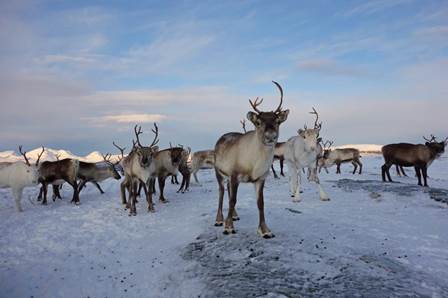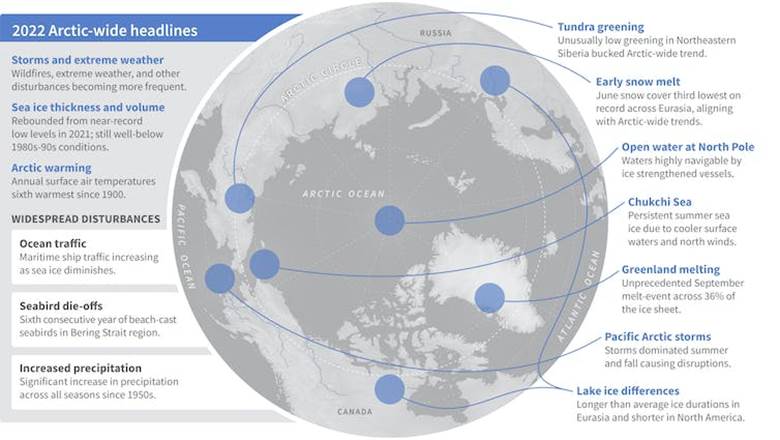Description

Copyright infringement not intended
Context: Nearly 150 experts from 11 nations compiled this year’s assessment of Arctic conditions, the Arctic Report Card, which NOAA has produced since 2006. This year’s report card was issued in Chicago at a conference of the American Geophysical Union, the society of earth, atmospheric and oceanic scientists.
Details:
- In the Arctic, the freedom to travel, hunt and make day-to-day decisions is profoundly tied to cold and frozen conditions for much of the year. These conditions are rapidly changing as the Arctic warms.
- The Arctic is now seeing more rainfall when historically it would be snowing. Sea ice that once protected coastlines from erosion during fall storms is forming later.
- And thinner river and lake ice is making travel by snowmobile increasingly life-threatening.
- Ship traffic in the Arctic is also increasing, bringing new risks to fragile ecosystems, and the Greenland ice sheet is continuing to send freshwater and ice into the ocean, raising global sea level

The Arctic is getting wetter and rainier
- We found that Arctic precipitation is on the rise across all seasons, and these seasons are shifting.
- Much of this new precipitation is now falling as rain, sometimes during winter and traditionally frozen times of the year. This disrupts daily life for humans, wildlife and plants.
- Roads become dangerously icy more often, and communities face greater risk of river flooding events. For Indigenous reindeer herding communities, winter rain can create an impenetrable ice layer that prevents their reindeer from accessing vegetation beneath the snow.
- Arctic-wide, this shift toward wetter conditions can disrupt the lives of animals and plants that have evolved for dry and cold conditions, potentially altering Arctic peoples’ local foods.
- There are multiple reasons for this increase in Arctic precipitation. As sea ice rapidly declines, more open water is exposed, which feeds increased moisture into the atmosphere. The entire Arctic region has seen a more than 40% loss in summer sea ice extentover the 44-year satellite record. The Arctic atmosphere is also warming more than twice as fast as the rest of the globe, and this warmer air can hold more moisture.
- Under the ground, the wetter, rainier Arctic is accelerating the thaw of permafrost, upon which most Arctic communities and infrastructure are built. The result is crumbling buildings, sagging and cracked roads, the emergence of sinkholes and the collapse of community coastlines along rivers and ocean.
- Wetter weather also disrupts the building of a reliable winter snowpack and safe, reliable river ice, and often challenges Indigenous communities’ efforts to harvest and secure their food.
Arctic snow season is shrinking
- Snow plays critical roles in the Arctic, and the snow season is shrinking.
- Snow helps to keep the Arctic cool by reflecting incoming solar radiation back to space, rather than allowing it to be absorbed by the darker snow-free ground. Its presence helps lake ice last longer into springand helps the land to retain moisture longer into summer, preventing overly dry conditions that are ripe for devastating wildfires.
- Snow is also a travel platform for hunters and a habitat for many animals that rely on it for nesting and protection from predators.
- A shrinking snow seasonis disrupting these critical functions.
- Even in the depth of winter, warmer temperatures are breaking through.
- Fatal falls through thin sea, lake and river ice are on the riseacross Alaska, resulting in immediate tragedies as well as adding to the cumulative human cost of climate change that Arctic Indigenous peoples are now experiencing on a generational scale.
Greenland ice melt means global problems
.jpg)
Human-caused change is reshaping the Arctic
- We are living in a new geological age — the Anthropocene— in which human activity is the dominant influence on our climate and environments.
- In the warming Arctic, this requires decision-makers to better anticipate the interplay between a changing climate and human activity. For example, satellite-based ship data since 2009 clearly show that maritime ship traffichas increased within all Arctic high seas and national exclusive economic zones as the region has warmed
.jpg)
https://indianexpress.com/article/explained/explained-climate/arctic-becoming-wetter-scientists-warn-8324925/







.jpg)






